Alignment to CORE and NGSS Standards

| Grade | Number | Standard |
|---|---|---|
| 1 | 1.MD.C.4 | Organize, represent, and interpret data with up to three categories; ask and answer questions about the total number of data points, how many in each category, and how many more or less are in one category than in another. |
| 1 | L.1.5a | Sort words into categories (e.g., colors, clothing) to gain a sense of the concepts the categories represent. |
| 1 | NGSS: 1-LS1.A: | All organisms have external parts. Different animals use their body parts in different ways to see, hear, grasp objects, protect themselves, move from place to place, and seek, find, and take in food, water and air. Plants also have different parts (roots, stems, leaves, flowers, fruits) that help them survive and grow. (1-LS1-1) |
| 1 | NGSS: 1-LS3.A | Young animals are very much, but not exactly, like their parents. Plants also are very much, but not exactly, like their parents. (1-LS3-1) |
| 1 | RI.1.9 | Identify basic similarities in and differences between two texts on the same topic. (story versus For Creative Minds non-fiction component) |
| 2 | NGSS: 2-LS4.D | There are many different kinds of living things in any area, and they exist in different places on land and in water. Classification (2-LS4-1) |
| 2 | RF.2.4a-Lexile Level | Read grade-level text with purpose and understanding. Lexile Level 420L - 820L |
| 2 | RI.2.10-Lexile Level | By the end of year, read and comprehend informational texts, including history/social studies, science, and technical texts, in the grades 2_3 text complexity band proficiently, with scaffolding as needed at the high end of the range. Lexile Level 420L - 820L |
| 2 | RI.2.3 | Describe the connection between scientific ideas or concepts, or steps in technical procedures in a text: Earth processes: quickly/slowly, wind/water shape land, plate tectonics, maps, water: ocean/rivers/lakes-solid or liquid, STEM: drawings, plant basic needs, seed dispersal, biodiversity, state of matter: solid/liquid, small objects make larger, heating/cooling substance causes observable change, add/subtract 100-20 mentally, equal groups for multiplication foundation, odd/even numbers, place value 3 digits, skip counting, measure length using 2 different measurements (inches/feet/yard/cm/m), compare objects by measurement, number line, time to 5 minutes, money/currency, line plot, picture graph, bar graph 4 categories, shapes/angles/number faces, divide shapes into halves, thirds, quarters, fables/folktales from diverse cultures, rhyme and rhythm, compare two/more versions same story, collective nouns |
| 2 | RI.2.4 | Determine the meaning of words and phrases in a text relevant to a grade 2 topic or subject area: Earth processes: quickly/slowly, wind/water shape land, plate tectonics, maps, water: ocean/rivers/lakes-solid or liquid, STEM: drawings, plant basic needs, seed dispersal, biodiversity, state of matter: solid/liquid, small objects make larger, heating/cooling substance causes observable change, add/subtract 100-20 mentally, equal groups for multiplication foundation, odd/even numbers, place value 3 digits, skip counting, measure length using 2 different measurements (inches/feet/yard/cm/m), compare objects by measurement, number line, time to 5 minutes, money/currency, line plot, picture graph, bar graph 4 categories, shapes/angles/number faces, divide shapes into halves, thirds, quarters, fables/folktales from diverse cultures, rhyme and rhythm, compare two/more versions same story, collective nouns |
| 2 | RL.2.10-Lexile Level | By the end of the year, read and comprehend literature, including stories and poetry, in the grades 2_3 text complexity band proficiently, with scaffolding as needed at the high end of the range. Lexile Level 420L - 820L |
| 3 | NGSS: 3-ESS2.D-1 | Scientists record patterns of the weather across different times and areas so that they can make predictions about what kind of weather might happen next. (3-ESS2-1) |
| 3 | NGSS: 3-ESS2.D-2 | Climate describes a range of an area’s typical weather conditions and the extent to which those conditions vary over years. (3-ESS2-2) |
| 3 | NGSS: 3-LS4.C | For any particular environment, some kinds of organisms survive well, some survive less well, and some cannot survive at all. (3-LS4-3) |
| 3 | RI.3.4 | Determine the meaning of general academic and domain-specific words and phrases in a text relevant to a grade 3 topic or subject area: Weather prediction, weather versus climate, natural hazards, life cycles, changing environments: organisms survive/move/adapt/die, animal group behavior, inherited traits, instinct/learned behavior, extinct animals, fossils, individual advantages survival/mating, habitat survival: physical/behavioral adaptations, living things change habitats, force/motion: strength/direction/electric/magnetic, multiplication/division, unknown number m/d equation, m/d fact families, two-step word problems, place value rounding, fractions, time to minute, liquid volumes, scaled picture graph/bar graph, measurements to fractional inches, line plot, area, square units, area=multiplication/division, perimeter, shapes in different categories (rhombus/rectangle=quadrilateral), divide shapes by equal area, fables/folktales/myths from diverse cultures, compare/contrast stories from same author/series, |
| 4 | NGSS: 4-LS1.A | Plants and animals have both internal and external structures that serve various functions in growth, survival, behavior, and reproduction. (4-LS1-1) |